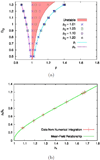Phase separation and emergent structures in an active nematic fluid
- PMID: 25375491
- PMCID: PMC4459651
- DOI: 10.1103/PhysRevE.90.042304
Phase separation and emergent structures in an active nematic fluid
Abstract
We consider a phenomenological continuum theory for an active nematic fluid and show that there exists a universal, model-independent instability which renders the homogeneous nematic state unstable to order fluctuations. Using numerical and analytic tools we show that, in the vicinity of a critical point, this instability leads to a phase-separated state in which the ordered regions form bands in which the direction of nematic order is perpendicular to the direction of the density gradient. We argue that the underlying mechanism that leads to this phase separation is a universal feature of active fluids of different symmetries.
Figures








Similar articles
-
Self-regulation in self-propelled nematic fluids.Eur Phys J E Soft Matter. 2012 Sep;35(9):95. doi: 10.1140/epje/i2012-12095-8. Epub 2012 Sep 28. Eur Phys J E Soft Matter. 2012. PMID: 23053844
-
Experimental and theoretical approach for the clustering of globally coupled density oscillators based on phase response.Phys Rev E. 2016 Jan;93(1):012212. doi: 10.1103/PhysRevE.93.012212. Epub 2016 Jan 20. Phys Rev E. 2016. PMID: 26871078
-
Phase transitions in wave turbulence.Phys Rev E Stat Nonlin Soft Matter Phys. 2012 Jan;85(1 Pt 1):010101. doi: 10.1103/PhysRevE.85.010101. Epub 2012 Jan 3. Phys Rev E Stat Nonlin Soft Matter Phys. 2012. PMID: 22400497
-
Spontaneous division and motility in active nematic droplets.Phys Rev Lett. 2014 Apr 11;112(14):147802. doi: 10.1103/PhysRevLett.112.147802. Epub 2014 Apr 10. Phys Rev Lett. 2014. PMID: 24766017
-
Active turbulence and spontaneous phase separation in inhomogeneous extensile active gels.Soft Matter. 2023 Jan 4;19(2):189-198. doi: 10.1039/d2sm01188c. Soft Matter. 2023. PMID: 36503973
Cited by
-
On the mechanism of long-range orientational order of fibroblasts.Proc Natl Acad Sci U S A. 2017 Aug 22;114(34):8974-8979. doi: 10.1073/pnas.1707210114. Epub 2017 Aug 7. Proc Natl Acad Sci U S A. 2017. PMID: 28784754 Free PMC article.
-
Aspects of the density field in an active nematic.Philos Trans A Math Phys Eng Sci. 2014 Nov 28;372(2029):20130364. doi: 10.1098/rsta.2013.0364. Philos Trans A Math Phys Eng Sci. 2014. PMID: 25332390 Free PMC article.
-
Spontaneous flow in polar active fluids: the effect of a phenomenological self propulsion-like term.Eur Phys J E Soft Matter. 2016 Jan;39(1):1. doi: 10.1140/epje/i2016-16001-2. Epub 2016 Jan 14. Eur Phys J E Soft Matter. 2016. PMID: 26769011
-
Self-organized dynamics and the transition to turbulence of confined active nematics.Proc Natl Acad Sci U S A. 2019 Mar 12;116(11):4788-4797. doi: 10.1073/pnas.1816733116. Epub 2019 Feb 25. Proc Natl Acad Sci U S A. 2019. PMID: 30804207 Free PMC article.
-
Instabilities, defects, and defect ordering in an overdamped active nematic.Soft Matter. 2016 May 7;12(17):3854-9. doi: 10.1039/c6sm00268d. Epub 2016 Mar 17. Soft Matter. 2016. PMID: 26983376 Free PMC article.
References
Publication types
MeSH terms
Grants and funding
LinkOut - more resources
Full Text Sources
Other Literature Sources
